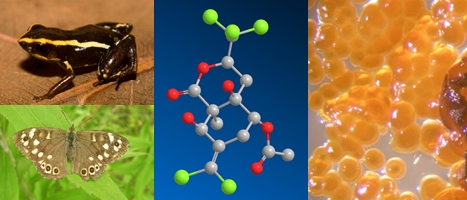

 |
 |
The Schulz Lab |
|||
| TU Braunschweig | Department of Life Sciences | Institute of Organic Chemistry | |||||
| Home Prof. Dr. S. Schulz Office Research Publications Group Members Alumni MACE Media Lectures Practical Courses Masters Thesis Bachelors Thesis Open Positions Centrum for Natural Product Chemistry Legal Notice Privacy |
ResearchOur group is interested in Natural Product Chemistry with a focus on Chemical Communication and Chemical Ecology, the understanding of the function of natural products in their original biological systems. The research covers the identification and isolation of compounds, their stereoselective synthesis and analysis, and studies on their biosynthesis in the living organism. Most work is done in close cooperation with biologists on specific systems. The aim is to understand why nature produces such compounds and to find potential uses. Four focus areas are currently investigated, detailed below.Chemical Communication in ArthropodsArthropods (e. g. insects and arachnids) are well known for the widespread use of semiochemicals, compounds mediating inter- and intraspecific interactions among individuals. Such compounds occur usually in low concentrations and need organic trace analysis methods as GC/MS for their identification. Structural proposals based on mass spectra need to be verified by synthesis. Often stereochemistry is important for biological activity and therefore enantiomer synthesis and analysis, e. g. by GC on chiral phases is often necessary. Varying projects especially on spiders, butterflies and hymenoptera are investigated together with biologists from all over the world.Bacterial Volatiles and CommunicationBacteria can produce a wealth of volatile compounds the function of which is currently only poorly understood. We aim to clarify the structural space used by the bacteria and investigate the function of these compounds. Volatiles can be collected by special methods applied by us and can be analyzed by GC/MS. Bacteria also communicate by "quorum sensing" using non-volatile compounds which are analyzed by HPLC/MSn. Target compounds are synthesized and evaluated in cooperation with biologists. A primary focus are marine bacteria as the roseobacters investigated together with a large consortium of scientists within the framework of the SFB-TRR 51 "Roseobacter", myxobacteria, and rhizobacteria.Chemical Communication Systems in Reptiles and AmphibiaAmphibia are known to produce water soluble pheromones, e. g. peptides as pheromones. We have shown that certain frogs can communicate via volatile chemicals as well. Different compound classes as alcohols, lactones, or terpenes are used in species specific mixtures for communication by African and Madagascan frogs. Reptiles also use skin gland contents for communication although the actual function of the compounds is less well explored. Alligators and Rhyncocephalia use sometimes unique chemistry, while lizards prefer common compounds. Access to gland contents is ensured by cooperation with biologists from Berlin, Vienna, the USA, and our zoology department.Antibiotic natural productsOne part of the group carries out total syntheses and syntheses of derivatives for new natural products potentially useful as new antibiotics. The target compounds originate either from our own work or through cooperation with groups from the Helmholtz-Center of Infection Diseases in Braunschweig and the Helmholtz-Center of Pharmaceutical Research in Saarbrücken. Due to the improved sensitivity of current analytical methods isolation of target compounds becomes increasingly difficult. Therefore, total synthesis can be a tool to elucidate a structure of an unknown natural product and also gives access to material for biological investigation.Expertise in our lab
Equipment
|